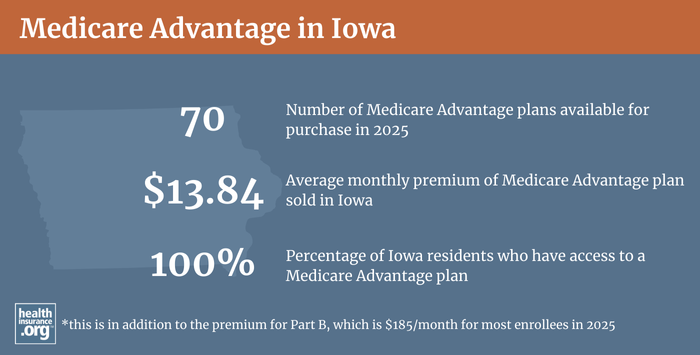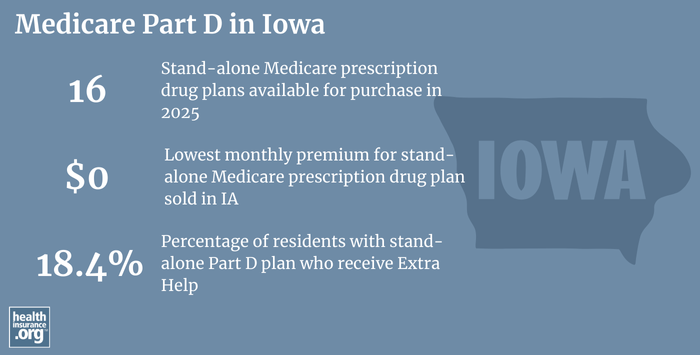Medicare in Iowa

Iowa lawmakers consider bill that would create a limited annual window when Medigap enrollees could buy a different plan without underwriting
Key Takeaways

Medicare enrollment in Iowa
As of August 2024, there were 684,668 residents with Medicare coverage in Iowa.1
In most cases, Medicare eligibility is triggered when a person turns 65. But Medicare also provides coverage for people under age 65 once they have been receiving disability benefits for 24 months, or if they have ALS or ESRD. Nationwide, almost 11% of Medicare beneficiaries are disabled and under age 65;3 in Iowa, 10% of the Medicare population is under 65 and eligible for Medicare coverage enrollment due to a disability.1
Learn about Medicare plan options in Iowa by contacting a licensed agent.



Explore our other comprehensive guides to coverage in Iowa

We’ve created this guide to help you understand the Iowa health insurance options available to you and your family, and to help you select the coverage that will best fit your needs and budget.


Hoping to improve your smile? Dental insurance may be a smart addition to your health coverage. Our guide explores dental coverage options in Iowa.


Learn about Iowa’s Medicaid expansion, the state’s Medicaid enrollment and Medicaid eligibility.


Short-term health plans provide temporary health insurance for consumers who may find themselves without comprehensive coverage. Learn more about short-term plan availability in Iowa.

Frequently asked questions about Medicare in Iowa
What is Medicare Advantage?
Beneficiaries of Medicare in Iowa can choose to get their coverage through private Medicare Advantage plans, or directly from the federal government via Original Medicare.
Medicare Advantage plans are offered by private insurers, so plan availability varies from one area to another. Iowa residents have up to 36 Medicare Advantage plan options available for purchase in 2024, depending on where they live.4 The Iowa Medicare Advantage buyer’s guide shows premiums and coverage areas for each of the insurers that offer Advantage plans in the state.
Nationwide, about half of all Medicare beneficiaries had Medicare Advantage plans as of August 2024.3 However, in Iowa, it was 37%.1 Some Iowa Medicare beneficiaries are enrolled in Medicare Cost plans, which are another form of private Medicare coverage. The other 429,256 Iowa Medicare beneficiaries had coverage under Original Medicare.1
Original Medicare coverage is provided directly by the federal government, and enrollees have access to a nationwide network of providers. But people with Original Medicare need supplemental coverage (from an employer-sponsored plan, Medicaid, or privately purchased plans) for things like prescription drugs and out-of-pocket costs (out-of-pocket costs are not capped under Original Medicare).
Original Medicare includes Part A (hospital coverage) and Part B (outpatient and physician services). Medicare Advantage plans include all of the coverage provided by Medicare Parts A and B — although out-of-pocket costs can vary significantly — and often include additional benefits, such as integrated Part D prescription drug coverage and coverage for things like dental and vision care, plus extras like gym memberships and nurse hotlines.
But Medicare Advantage insurers establish their own provider networks, which are generally localized and more limited than the nationwide network for Original Medicare. And out-of-pocket costs for Medicare Advantage are often higher than they would be if a beneficiary had Original Medicare plus a Medigap plan. There are pros and cons to either option, and the right solution is different for each person.
Medicare’s annual election period (October 15 to December 7 each year) allows Medicare beneficiaries the chance to switch between Medicare Advantage enrollment and Original Medicare (and add, drop, or switch to a different Medicare Part D prescription plan). People who are already enrolled in Medicare Advantage also have the option to change to a different Advantage plan or to Original Medicare during the Medicare Advantage open enrollment period, which runs from January 1 to March 31.

What are Medigap plans?
Original Medicare does not limit out-of-pocket costs, so most enrollees maintain some form of supplemental coverage. Nationwide, more than half of Original Medicare beneficiaries get their supplemental coverage through an employer-sponsored plan or Medicaid. But for those who don’t, Medigap plans (also known as Medicare supplement plans, or MedSupp) will pay some or all of the out-of-pocket costs (deductibles and coinsurance) they would otherwise have to pay if they had only Original Medicare.
306,087 Iowa Medicare beneficiaries were enrolled in Medigap plans as of 2020, according to an AHIP analysis. That’s about two-thirds of the state’s Original Medicare enrollees (Medigap coverage cannot be used with Medicare Advantage plans).
Although Medigap plans are sold by private insurers, the plans are standardized under federal rules, with ten different plan designs (differentiated by letters, A through N). The benefits offered by a particular plan (Plan A, Plan F, etc.) are the same regardless of which insurer sells the plan.
There were 46 insurers offering Medigap plans in Iowa for 2025.5
Medigap plans in the state are governed by Chapter 37 of Iowa insurance statute. In 2019, regulators proposed updates to Chapter 37, including adjustments to comply with federal rules for Medigap plans starting in 2020, prohibiting newly-eligible enrollees from buying Medigap plans that cover the Part B deductible; the revised Iowa code is Rule 191-37.9. Medigap insurers in Iowa are required to spend at least 65% of premiums (75% for group plans) on benefits for enrollees, as opposed to administrative costs.
Medigap insurers in Iowa can use issue-age rating (premiums are based on the age you were when you bought the policy) or attained-age rating (premiums go up as you get older). Almost all of the insurers in the state — all but AARP/UnitedHealthcare, Everence Association, and Transamerica — use attained-age rating.
Iowa considers legislation to create a limited annual window for Medigap plan changes
Unlike other private Medicare coverage (Medicare Advantage and Medicare Part D plans), there is no annual open enrollment window for Medigap plans. Instead, federal rules provide a one-time six-month window when Medigap coverage is guaranteed-issue. This window starts when a person is at least 65 and enrolled in Medicare Part B (you must be enrolled in both Part A and Part B to buy a Medigap plan).
In 2023, Iowa lawmakers are considering legislation (HF462, which passed unanimously in Iowa’s House in March 2023) that would create an annual window (March 1 – March 31) during which Medigap enrollees would have the opportunity to switch to a different Medigap plan without medical underwriting or pricing discrimination. Each insurer that sells Medigap plans in the state would have to designate at least one plan that would be available on a guaranteed-issue basis to an applicant using this window. The window would be restricted to people who already have existing Medigap coverage, but that would include beneficiaries who are under age 65 and enrolled due to a disability (as described in a moment, initial enrollment opportunities for these beneficiaries are quite limited in Iowa, and HF462 does not change that).
People who aren’t yet 65 can enroll in Medicare if they’re disabled and have been receiving disability benefits for at least two years, or if they have ALS or kidney failure. About 10% of Iowa’s Medicare beneficiaries are under age 65.1 But federal rules do not guarantee access to Medigap plans for people who are under 65.
The majority of the states have implemented rules to ensure that disabled Medicare beneficiaries have at least some access to Medigap plans, but Iowa is not among them. Medigap insurers in Iowa have the option to offer coverage to disabled enrollees who aren’t yet 65, but most do not. As of 2023, according to Medicare’s plan finder tool, United American and Wellmark offer several Medigap plans to people under 65, but the premiums are quite a bit more expensive than the rates for a 65-year-old.
Disabled Medicare beneficiaries under age 65 in Iowa also have the option to enroll in HIPIOWA, the state’s high-risk health insurance pool. HIPIOWA has a plan that provides coverage to supplement Medicare, with premiums that vary based on age. Iowa is one of several states where state-run high-risk pools are still operational, with supplemental coverage available to Medicare beneficiaries who are unable to obtain private Medigap plans. The others are Alaska, Nebraska, New Mexico, North Dakota, South Carolina, Washington, and Wyoming.
Disabled Medicare beneficiaries have access to the normal Medigap open enrollment period when they turn 65. At that point, they can select from among any of the available Medigap plans, with standard premiums that apply to non-disabled people who are enrolling when they turn 65.
Disabled Medicare beneficiaries also have the option to enroll in a Medicare Advantage plan instead of Original Medicare. Medicare Advantage premiums are not higher for those under 65. But as noted above, Advantage plans have more limited provider networks than Original Medicare, and total out-of-pocket costs can be as high as $8,300 per year for in-network care, plus the out-of-pocket cost of prescription drugs (many Advantage plans continue to have out-of-pocket limits well below the federally-allowed maximum).
Although the Affordable Care Act eliminated pre-existing condition exclusions in most of the private health insurance market, those rules don’t apply to Medigap plans. Medigap insurers can impose a pre-existing condition waiting period of up to six months if you didn’t have at least six months of continuous coverage prior to your enrollment (although many of them choose not to do so). And if you apply for a Medigap plan after your initial enrollment window closes (assuming you aren’t eligible for one of the limited guaranteed-issue rights), the Medigap insurer can consider your medical history in determining whether to accept your application, and at what premium.
What is Medicare Part D?
Original Medicare does not provide coverage for outpatient prescription drugs. More than half of Original Medicare beneficiaries nationwide have supplemental coverage via an employer-sponsored plan (from a current or former employer or spouse’s employer) or Medicaid, and these plans often include prescription coverage.
But Medicare beneficiaries who do not have drug coverage through Medicaid or an employer-sponsored plan need Medicare Part D in order to have coverage for prescriptions. Medicare Part D was created under the Medicare Modernization Act of 2003. Part D coverage can be purchased as a stand-alone plan, or obtained as part of a Medicare Advantage with integrated Part D benefits.
There are 16 stand-alone Medicare Part D plans for sale in Iowa for 2025, with premiums that start at $0/month.2
More than 343,678 Iowa residents had stand-alone Medicare Part D plans as of August 2024. Another 231,411 Iowa Medicare beneficiaries had Part D prescription coverage as part of their Medicare Advantage plans.1
Medicare Part D enrollment is available during the same annual open enrollment period that applies to Medicare Advantage plans, running from October 15 to December 7 each fall. Plan changes made during this window take effect on January 1 of the coming year.

How does Medicaid provide financial assistance to Medicare beneficiaries in Iowa?
Many Medicare beneficiaries receive financial assistance through Medicaid with the cost of Medicare premiums, prescription drug expenses, and services Medicare doesn’t cover – such as long-term care.
Our guide to financial help for Medicare enrollees in Iowa includes overviews of these benefits, including Medicare Savings Programs, long-term care coverage, and eligibility guidelines for assistance.
What additional resources are available for Medicare beneficiaries and their caregivers in Iowa?
Need help with Medicare enrollment in Iowa, or have questions about Medicare eligibility or benefits? You can contact SHIIP, Iowa’s Senior Health Insurance Information Program, with questions related to Medicare enrollment and coverage in Iowa.
The Iowa Insurance Division can answer questions and address consumer complaints about health insurance companies that offer Medicare plans, as well as the agents and brokers who sell those plans. The Division also has a Medicare Resource Page.
The Medicare Rights Center is a nationwide service, with a website and call center, that provides information and assistance related to Medicare enrollment, eligibility, and benefits.
This resource about how Iowa Medicaid assists Medicare beneficiaries with limited financial means is a useful guide for beneficiaries and their caregivers.
Louise Norris is an individual health insurance broker who has been writing about health insurance and health reform since 2006. She has written dozens of opinions and educational pieces about the Affordable Care Act for healthinsurance.org.
Footnotes
- “Medicare Monthly Enrollment – Iowa.” Centers for Medicare & Medicaid Services Data. Accessed December, 2024. ⤶ ⤶ ⤶ ⤶ ⤶ ⤶ ⤶ ⤶
- ”Fact Sheet: Medicare Open Enrollment for 2025” (47) Centers for Medicare & Medicaid Services. Sep. 27, 2024 ⤶ ⤶
- “Medicare Monthly Enrollment – US” Centers for Medicare & Medicaid Services Data, December 2024. ⤶ ⤶
- ”Medicare Advantage 2024 Spotlight: First Look” KFF.org Nov. 15, 2023 ⤶
- “Explore your Medicare coverage options.” Medicare.gov. Accessed October, 2024. ⤶

